当前位置:
X-MOL 学术
›
J. Electroanal. Chem.
›
论文详情
Our official English website, www.x-mol.net, welcomes your
feedback! (Note: you will need to create a separate account there.)
Photo-assisted acid-base machine: Battery ensemble to perform work from neutralization reactions
Journal of Electroanalytical Chemistry ( IF 4.1 ) Pub Date : 2018-08-01 , DOI: 10.1016/j.jelechem.2018.06.047 William G. Morais , Gilberto Lima , Wellington J.A.S. Gomes , Fritz Huguenin
Journal of Electroanalytical Chemistry ( IF 4.1 ) Pub Date : 2018-08-01 , DOI: 10.1016/j.jelechem.2018.06.047 William G. Morais , Gilberto Lima , Wellington J.A.S. Gomes , Fritz Huguenin

|
Abstract This study proposes a power source that operates between acidic and basic reservoirs under sunlight to treat acidic wastewater sustainably. We present a strategy that harvests energy from an ionic gradient associated with acidic solution neutralization and water photo-oxidation under UV light. In contrast to neutralization batteries, these photo-assisted acid-base machines operate with an interconnected battery ensemble comprising (A) a photo-assisted acid battery composed of photo-anode (TiO2) for water photo-oxidation and a selective self-assembled cathode consisting of poly(3,4-ethylenedioxythiophene) and phosphomolybdic acid for proton insertion; (B) a proton-alkali ion battery composed of the self-assembled electrode for proton deinsertion and a cathode made of copper hexacyanoferrate for potassium ion electro-insertion, which can be used as portable or stationary power source; (C) an alkali ion-air battery composed of the polycyanometalate for potassium ion deinsertion and a platinum cathode for the oxygen reduction reaction (ORR). This ensemble avoids reverse water splitting reactions and dismisses the need for external electrical power sources, which increases machine efficiency. Experiments demonstrate that acidic solution neutralization from pH = 1.3 to pH = 6.0 can harvest 102.6 kJ per mol of electro-inserted proton: this process converts energy from sunlight and from ionic gradient into electrical work. Therefore, the strategy presented here may contribute to environmental preservation and sustainable growth.
中文翻译:

光辅助酸碱机:电池组执行中和反应工作
摘要 本研究提出了一种在阳光下在酸性和碱性水库之间运行的电源,以可持续地处理酸性废水。我们提出了一种从与酸性溶液中和和紫外线下水光氧化相关的离子梯度中获取能量的策略。与中和电池相比,这些光辅助酸碱机与互连的电池组一起运行,包括 (A) 由用于水光氧化的光阳极 (TiO2) 和选择性自组装阴极组成的光辅助酸电池由聚(3,4-亚乙基二氧噻吩)和磷钼酸组成,用于插入质子;(B) 由自组装的用于质子脱嵌的电极和用于钾离子电插入的六氰基铁酸铜制成的阴极组成的质子碱离子电池,可用作便携式或固定电源;(C) 由用于钾离子脱嵌的聚氰基金属酸盐和用于氧还原反应 (ORR) 的铂阴极组成的碱性离子空气电池。该整体避免了反向水分解反应,并消除了对外部电源的需求,从而提高了机器效率。实验表明,从 pH = 1.3 到 pH = 6.0 的酸性溶液中和每摩尔电插入质子可以收获 102.6 kJ:这个过程将来自阳光和离子梯度的能量转化为电功。因此,这里提出的战略可能有助于环境保护和可持续增长。(C) 由用于钾离子脱嵌的聚氰基金属酸盐和用于氧还原反应 (ORR) 的铂阴极组成的碱性离子空气电池。该整体避免了反向水分解反应,并消除了对外部电源的需求,从而提高了机器效率。实验表明,从 pH = 1.3 到 pH = 6.0 的酸性溶液中和每摩尔电插入质子可以收获 102.6 kJ:这个过程将来自阳光和离子梯度的能量转化为电功。因此,这里提出的战略可能有助于环境保护和可持续增长。(C) 由用于钾离子脱嵌的聚氰基金属酸盐和用于氧还原反应 (ORR) 的铂阴极组成的碱性离子空气电池。该整体避免了反向水分解反应,并消除了对外部电源的需求,从而提高了机器效率。实验表明,从 pH = 1.3 到 pH = 6.0 的酸性溶液中和每摩尔电插入质子可以收获 102.6 kJ:这个过程将来自阳光和离子梯度的能量转化为电功。因此,这里提出的战略可能有助于环境保护和可持续增长。实验表明,从 pH = 1.3 到 pH = 6.0 的酸性溶液中和每摩尔电插入质子可以收获 102.6 kJ:这个过程将来自阳光和离子梯度的能量转化为电功。因此,这里提出的战略可能有助于环境保护和可持续增长。实验表明,从 pH = 1.3 到 pH = 6.0 的酸性溶液中和每摩尔电插入质子可以收获 102.6 kJ:这个过程将来自阳光和离子梯度的能量转化为电功。因此,这里提出的战略可能有助于环境保护和可持续增长。
更新日期:2018-08-01
中文翻译:

光辅助酸碱机:电池组执行中和反应工作
摘要 本研究提出了一种在阳光下在酸性和碱性水库之间运行的电源,以可持续地处理酸性废水。我们提出了一种从与酸性溶液中和和紫外线下水光氧化相关的离子梯度中获取能量的策略。与中和电池相比,这些光辅助酸碱机与互连的电池组一起运行,包括 (A) 由用于水光氧化的光阳极 (TiO2) 和选择性自组装阴极组成的光辅助酸电池由聚(3,4-亚乙基二氧噻吩)和磷钼酸组成,用于插入质子;(B) 由自组装的用于质子脱嵌的电极和用于钾离子电插入的六氰基铁酸铜制成的阴极组成的质子碱离子电池,可用作便携式或固定电源;(C) 由用于钾离子脱嵌的聚氰基金属酸盐和用于氧还原反应 (ORR) 的铂阴极组成的碱性离子空气电池。该整体避免了反向水分解反应,并消除了对外部电源的需求,从而提高了机器效率。实验表明,从 pH = 1.3 到 pH = 6.0 的酸性溶液中和每摩尔电插入质子可以收获 102.6 kJ:这个过程将来自阳光和离子梯度的能量转化为电功。因此,这里提出的战略可能有助于环境保护和可持续增长。(C) 由用于钾离子脱嵌的聚氰基金属酸盐和用于氧还原反应 (ORR) 的铂阴极组成的碱性离子空气电池。该整体避免了反向水分解反应,并消除了对外部电源的需求,从而提高了机器效率。实验表明,从 pH = 1.3 到 pH = 6.0 的酸性溶液中和每摩尔电插入质子可以收获 102.6 kJ:这个过程将来自阳光和离子梯度的能量转化为电功。因此,这里提出的战略可能有助于环境保护和可持续增长。(C) 由用于钾离子脱嵌的聚氰基金属酸盐和用于氧还原反应 (ORR) 的铂阴极组成的碱性离子空气电池。该整体避免了反向水分解反应,并消除了对外部电源的需求,从而提高了机器效率。实验表明,从 pH = 1.3 到 pH = 6.0 的酸性溶液中和每摩尔电插入质子可以收获 102.6 kJ:这个过程将来自阳光和离子梯度的能量转化为电功。因此,这里提出的战略可能有助于环境保护和可持续增长。实验表明,从 pH = 1.3 到 pH = 6.0 的酸性溶液中和每摩尔电插入质子可以收获 102.6 kJ:这个过程将来自阳光和离子梯度的能量转化为电功。因此,这里提出的战略可能有助于环境保护和可持续增长。实验表明,从 pH = 1.3 到 pH = 6.0 的酸性溶液中和每摩尔电插入质子可以收获 102.6 kJ:这个过程将来自阳光和离子梯度的能量转化为电功。因此,这里提出的战略可能有助于环境保护和可持续增长。











































 京公网安备 11010802027423号
京公网安备 11010802027423号